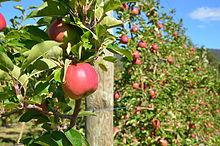Tree Pull Scheme

The Tree Pull Scheme was an Australian government initiative introduced in the 1970s to address an oversupply in the apple market and reduce economic pressures on the apple industry. The scheme aimed to lower production by offering financial incentives for the removal of apple trees, resulting in a reduction of the total apple tree count from 7.22 million in 1973 to 5.34 million by 1977.[1]
The scheme had a significant impact on Tasmania, then Australia's largest producer of apples, accounting for 30% of all apple production.[1] Regions such as the Huon Valley, historically known as the "Apple Valley,"[2] were heavily affected, along with other apple-growing areas including the Derwent Valley, Tasman Peninsula, Mersey Valley, and Tamar Valley.
Background
[edit]
Tasmania became a global apple supplier in the late 19th and early 20th centuries, thanks to its ideal growing conditions, agricultural innovations, and favorable trade arrangements. The temperate climate and fertile soil in regions like the Huon Valley and Channel region made Tasmania particularly suited for apple production. By the 1880s, Tasmania was a major apple supplier to the British Empire.[3]

Government support and advances in shipping, including refrigerated transport, solidified Tasmania’s reputation for high-quality apples. Known as the "Apple Isle," Tasmania dominated Australia's apple industry, with apples becoming a key export.[4] At its peak, apples represented 60% of Tasmanian agricultural exports, with the United Kingdom as the primary market.[5]
Britain’s 1961 application to join the European Economic Community (EEC) raised concerns for Australia, as its apple industry relied heavily on British markets. Britain advocated for Commonwealth interests but faced resistance from the EEC, which prioritised trade with closer regions and had protectionist policies like the Common Agricultural Policy (CAP), disadvantaging Australian agricultural exports.[6]
In 1973, the UK joined the EEC, limiting Tasmania's access to its primary market. Combined with rising production costs and global competition, this created an economic crisis for the apple industry.[7]
Implementation
[edit]The Australian Government, in partnership with the Tasmanian Government, introduced the Tree Pull Scheme to stabilise apple prices and support farmers facing economic hardship. The scheme provided financial incentives for farmers to uproot apple trees and reduce orchard sizes, helping orchardists transition to other agricultural activities or retire from apple farming.[5] Running from 1972 to 1975, the scheme removed around 1.88 million apple trees and reduced the number of orchardists in Tasmania by approximately 700.[8]
Impact
[edit]
The Tree Pull Scheme had significant economic, cultural, and social effects on the Tasmanian apple industry and its communities. The decline in apple production altered the identity of regions like the Huon Valley, which had depended on the apple trade.[9] Many apple varieties, some unique to Tasmania, were lost, impacting regional biodiversity.[10]
Economic challenges followed, with declines in employment and local business activity. Farmers faced difficulties transitioning to other industries, with some leaving agriculture altogether.[11] Between 1977 and 1986, Tasmania fell from Australia's largest apple producer to third.[12]
Legacy
[edit]Though the Tree Pull Scheme drew criticism for its impact on Tasmania’s apple industry, it also spurred discussions on sustainable agriculture and agricultural diversification in Tasmania. Recently, there has been renewed interest in heritage apple varieties, and local initiatives now promote apple tourism and cider production as economic alternatives.[13] Today, Tasmania’s apple industry, though smaller, focuses on niche markets, heritage varieties, cider production, and apple-based tourism.
See also
[edit]Sources
[edit]- McConnell, Anne Denise; Servant, Nathalie; Queen Victoria Museum and Art Gallery (Launceston, Tas.); National Estate Grants Program (Australia) (1999), The History and Heritage of the Tasmanian Apple Industry: A Profile, Queen Victoria Museum and Art Gallery, retrieved 6 November 2024
References
[edit]- ^ a b "Farming", There's Discord on the Apple Isle, Kenneth Graham, Sydney, N.S.W: The Bulletin (Australian periodical), 1978, ISSN 0007-4039, nla.obj-1606059440, retrieved 6 November 2024 – via Trove
- ^ "Tree Pull Scheme". The Companion to Tasmanian History. University of Tasmania. Retrieved 5 November 2024.
- ^ "Tasmanian Apples Shipped to England". Australian Food Timeline. September 1880. Retrieved 5 November 2024.
- ^ "Apple Industry". The Companion to Tasmanian History. University of Tasmania. Retrieved 5 November 2024.
- ^ a b "The Apple and Pear Industry". Tasmanian Pioneers and Historical Society. Retrieved 5 November 2024.
- ^ Ludlow, N. Piers (2001). "Too Far Away, Too High and Too Stable: The EEC and Trade with Australia During the 1960s". Australian Economic History Review. 41 (3): 267–286. doi:10.1111/1467-8446.00087. ISSN 0004-8992.
- ^ "The Demise of Tasmania's Apple Industry". The Friends' School. 5 August 2021. Retrieved 5 November 2024.
- ^ "A New Apple Future for Tasmania – Any Hope?". Australian Food Sovereignty Alliance. 18 March 2015. Retrieved 5 November 2024.
- ^ "Australian Apple Varieties and Their Legacy in Tasmania". ABC News. 3 September 2020. Retrieved 5 November 2024.
- ^ "Apples of the Huon - Part Two". Tasmanian Geographic. 14 November 2014. Retrieved 5 November 2024.
- ^ "Submission to Joint Committee on Public Accounts and Audit". Australian Parliament House. Retrieved 5 November 2024.
- ^ Australian Apple and Pear Corporation. (1976), "13 v. ; 25 cm.", Report, Parliamentary paper (Australia. Parliament), Melbourne: Australian Apple and Pear Corporation, p. 29, ISSN 0728-6570, nla.obj-2064213340, retrieved 6 November 2024 – via Trove
- ^ "Apple Isle: The Revival of Tasmania's Apple Heritage". ABC News. 7 May 2022. Retrieved 5 November 2024.
